Spring Bean的生命周期是Spring面试热点问题。Spring Bean的生命周期指的是从一个普通的Java类变成Bean的过程,深知Spring源码的人都知道这个给面试官讲的话大可讲30分钟以上,如果你不没有学习过Spring的源码,可能就知道Aware接口和调用init方法这样的生命周期,所以这个问题既考察对Spring的微观了解,又考察对Spring的宏观认识,想要答好并不容易!本文希望能够从源码角度入手,帮助面试者彻底搞定Spring Bean的生命周期。
总体的创建过程
首先你要明白一点,Spring Bean总体的创建过程如下:
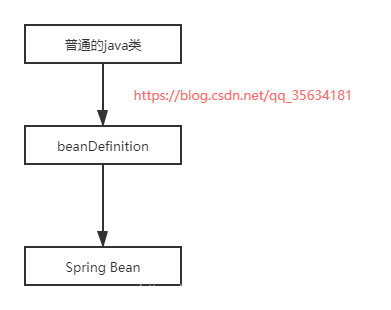
以注解类变成Spring Bean为例,Spring会扫描 指定包 下面的Java类,然后根据Java类构建beanDefinition对象,然后再根据beanDefinition来创建Spring的bean,特别要记住一点,Spring是根据beanDefinition来创建Spring bean的,关于beanDefinition下文会进行分析。
beanDefinition
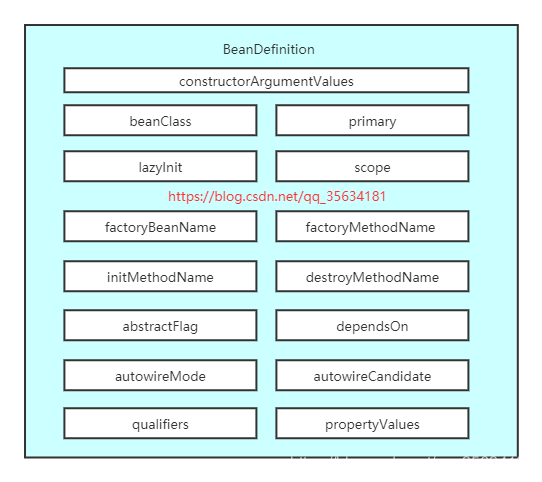
上图就是beanDefinition所包含的内容,看到这些属性如果对Spring有所了解都应该知道几个,如lazyInit懒加载,在Spring中有一个 @Lazy 注解,用来标识其这个bean是否为懒加载的,scope属性,相应的也有 @scope 注解来标识这个bean其作用域,是单例还是多例,beanClass属性,在对象实例化时,会根据beanClass来创建对象、又比如autowireMode注入模型这个属性,这个属性用于记录使用怎样的注入模型,注入模型常用的有根据名称和根据类型、不注入三种注入模型。
autowireMode虽然看似我们没有使用到过,但是知道这个对于查看Spring和其他框架整合的时候很有帮助,如果我们在beanDefinition指定其根据类型进行属性注入,那么在创建这个bean时,会将其beanClass中的所有属性都拿到,然后排出调基本属性(如类型String、Double、Boolean、Object),然后对于剩下的进行属性注入,记住一点,在beanDefinition指定其根据类型进行属性注入,即使不在属性上面使用 @Autowired 注解也会对其进行属性注入。在我们写注解类的时候为什么不使用 @Autowired 时,其属性就注入不进来呢?那是因为注解类在变成beanDefinition时,其注入类型是不注入,所以此时只有使用 @Autowired 注解进行标记的属性,才会完成依赖注入。
说了这么多,总之大家要记住Spring会根据beanDefinition来完成bean的创建,为什么不直接使用对象的class对象来创建bean呢?因为在class对象仅仅能描述一个对象的创建,它不足以用来描述一个Spring bean,而对于是否为懒加载、是否是首要的、初始化方法是哪个、销毁方法是哪个,这个Spring中特有的属性在class对象中并没有,所有Spring就定义了beanDefinition来完成bean的创建。
java类 -> beanDefinition对象
所以说如果要说Bean的生命周期,你不能不说Java类是在那一步变成beanDefinition的,我们先来看一下Spring中AbstractApplicationContext类中的refresh方法,这个方法就可以总结上面的图。
@Override
public void refresh() throws BeansException, IllegalStateException {
synchronized (this.startupShutdownMonitor) {
// Prepare this context for refreshing.
准备工作包括设置启动时间,是否激活标识位,
// 初始化属性源(property source)配置
prepareRefresh();
// Tell the subclass to refresh the internal bean factory.
//返回一个factory 为什么需要返回一个工厂
//因为要对工厂进行初始化
ConfigurableListableBeanFactory beanFactory = obtainFreshBeanFactory();
// Prepare the bean factory for use in this context.
//准备工厂
prepareBeanFactory(beanFactory);
try {
// Allows post-processing of the bean factory in context subclasses.
//这个方法在当前版本的spring是没用任何代码的
//可能spring期待在后面的版本中去扩展吧
postProcessBeanFactory(beanFactory);
// Invoke factory processors registered as beans in the context.
//在spring的环境中去执行已经被注册的 factory processors
//设置执行自定义的ProcessBeanFactory 和spring内部自己定义的
invokeBeanFactoryPostProcessors(beanFactory);
// Register bean processors that intercept bean creation.
//注册beanPostProcessor
registerBeanPostProcessors(beanFactory);
// Initialize message source for this context.
initMessageSource();
// Initialize event multicaster for this context.
//初始化应用事件广播器
initApplicationEventMulticaster();
// Initialize other special beans in specific context subclasses.
onRefresh();
// Check for listener beans and register them.
registerListeners();
// Instantiate all remaining (non-lazy-init) singletons.
finishBeanFactoryInitialization(beanFactory);
// Last step: publish corresponding event.
finishRefresh();
}
catch (BeansException ex) {
if (logger.isWarnEnabled()) {
logger.warn("Exception encountered during context initialization - " +
"cancelling refresh attempt: " + ex);
}
// Destroy already created singletons to avoid dangling resources.
destroyBeans();
// Reset 'active' flag.
cancelRefresh(ex);
// Propagate exception to caller.
throw ex;
}
finally {
// Reset common introspection caches in Spring's core, since we
// might not ever need metadata for singleton beans anymore...
resetCommonCaches();
}
}
}
有关Spring Bean生命周期最主要的方法有三个invokeBeanFactoryPostProcessors、registerBeanPostProcessors和finishBeanFactoryInitialization。
其中invokeBeanFactoryPostProcessors方法会执行BeanFactoryPostProcessors后置处理器及其子接口BeanDefinitionRegistryPostProcessor,执行顺序先是执行BeanDefinitionRegistryPostProcessor接口的postProcessBeanDefinitionRegistry方法,然后执行BeanFactoryPostProcessor接口的postProcessBeanFactory方法。
对于BeanDefinitionRegistryPostProcessor接口的postProcessBeanDefinitionRegistry方法,该步骤会扫描到指定包下面的标有注解的类,然后将其变成BeanDefinition对象,然后放到一个Spring中的Map中,用于下面创建Spring bean的时候使用这个BeanDefinition
其中registerBeanPostProcessors方法根据实现了PriorityOrdered、Ordered接口,排序后注册所有的BeanPostProcessor后置处理器,主要用于Spring Bean创建时,执行这些后置处理器的方法,这也是Spring中提供的扩展点,让我们能够插手Spring bean创建过程。
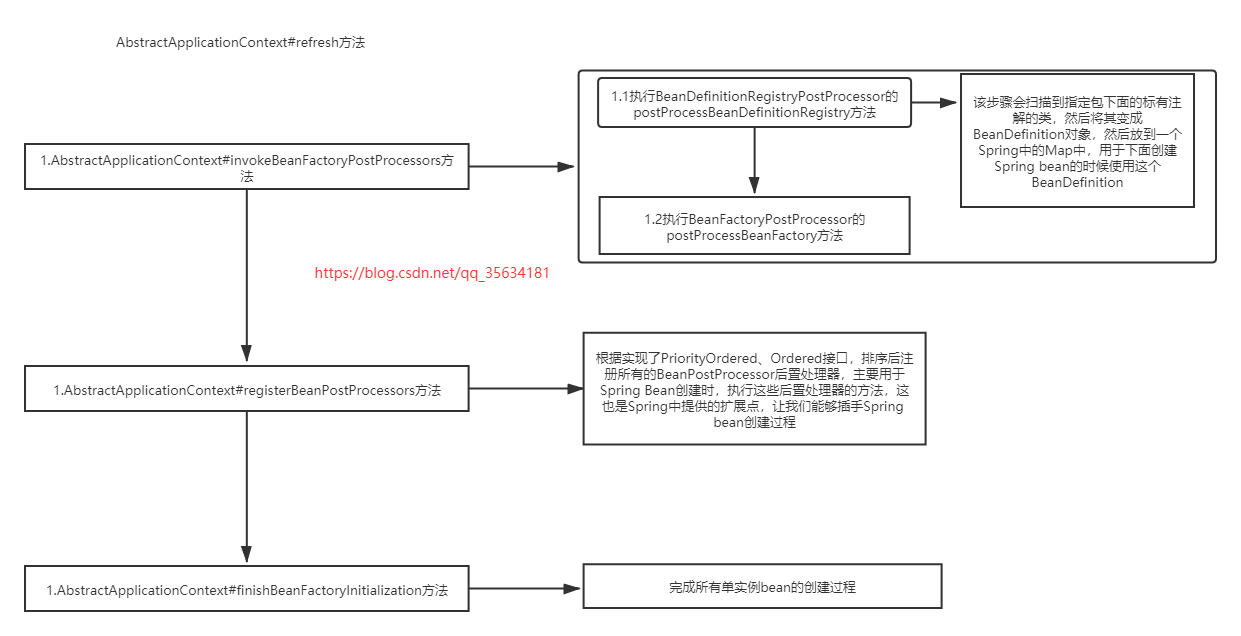
beanDefinition对象 -> Spring中的bean
finishBeanFactoryInitialization是完成非懒加载的Spring bean的创建的工作,你要想说Spring的生命周期,不要整其他没用的,直接告诉他在该步骤中会有8个后置处理的方法4个后置处理器的类贯穿在对象的实例化、赋值、初始化、和销毁的过程中,这4个后置处理器出现的地方分别为:
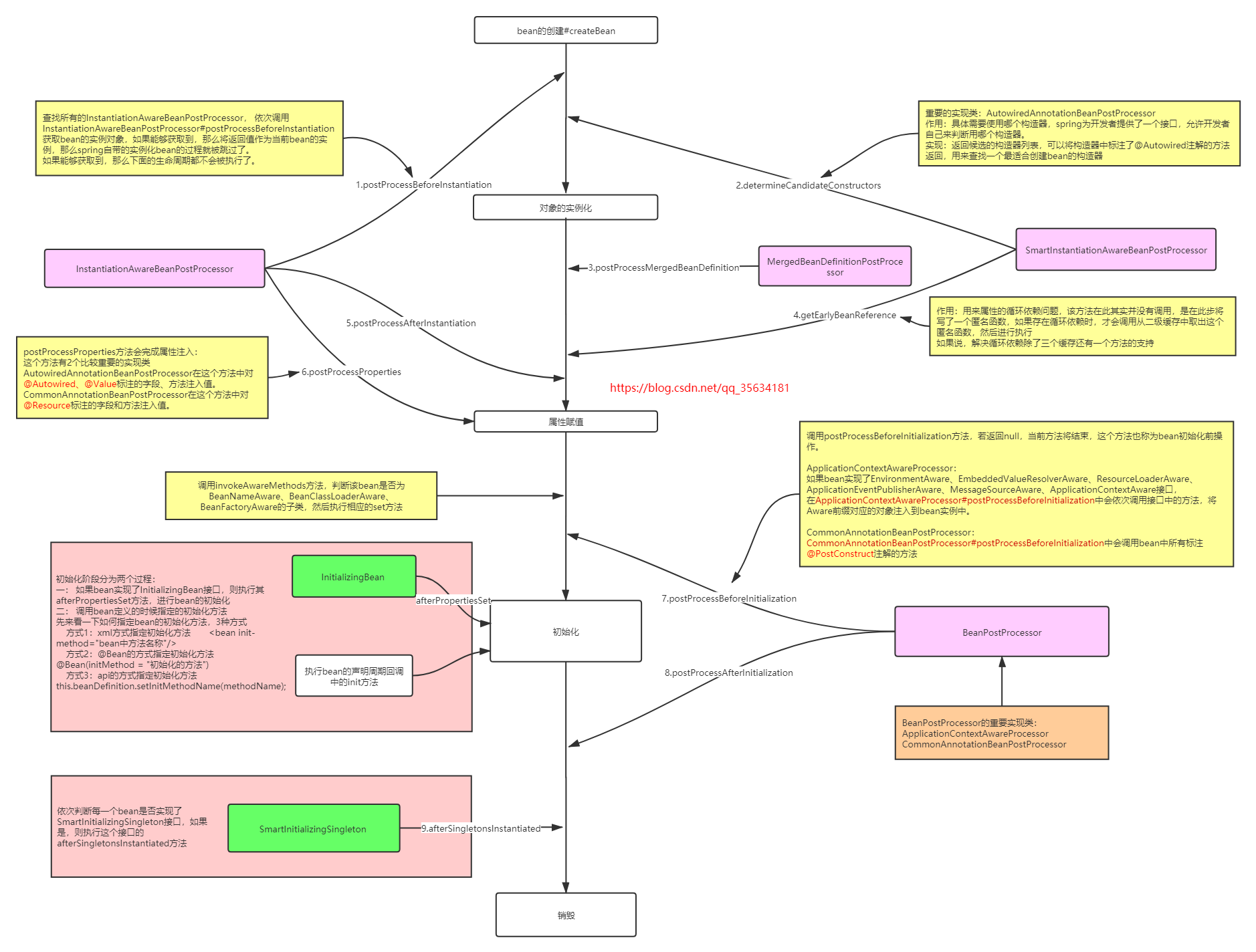
关于每个后置处理的作用如下:
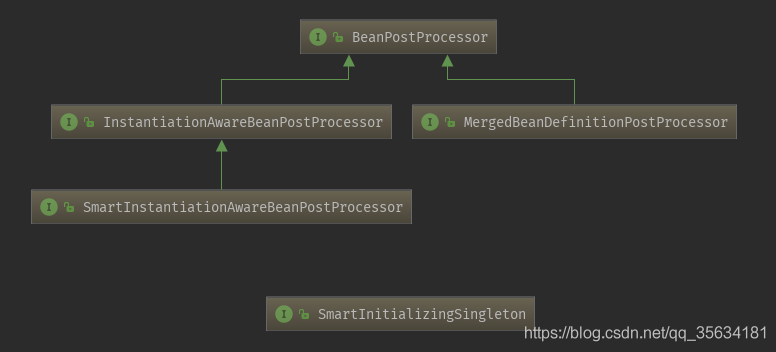
首先看一下继承关系,InstantiationAwareBeanPostProcessor、SmartInstantiationAwareBeanPostProcessor、MergedBeanDefinitionPostProcessor直接或间接的继承BeanPostProcessor,而SmartInitializingSingleton则是单独的一个接口。
一、InstantiationAwareBeanPostProcessor
InstantiationAwareBeanPostProcessor接口继承BeanPostProcessor接口,它内部提供了3个方法,再加上BeanPostProcessor接口内部的2个方法,所以实现这个接口需要实现5个方法。InstantiationAwareBeanPostProcessor接口的主要作用在于目标对象的实例化过程中需要处理的事情,包括实例化对象的前后过程以及实例的属性设置
在org.springframework.beans.factory.support.AbstractAutowireCapableBeanFactory#createBean()方法的Object bean = resolveBeforeInstantiation(beanName, mbdToUse);方法里面执行了这个后置处理器
二、SmartInstantiationAwareBeanPostProcessor
智能实例化Bean后置处理器(继承InstantiationAwareBeanPostProcessor)
三、MergedBeanDefinitionPostProcessor
四、SmartInitializingSingleton
智能初始化Singleton,该接口只有一个方法,是在所有的非懒加载单实例bean都成功创建并且放到Spring IOC容器之后进行执行的。
下面按照图中的顺序进行说明每个后置处理的作用:
1、InstantiationAwareBeanPostProcessor# postProcessBeforeInstantiation
在目标对象实例化之前调用,方法的返回值类型是Object,我们可以返回任何类型的值。由于这个时候目标对象还未实例化,所以这个返回值可以用来代替原本该生成的目标对象的实例(一般都是代理对象)。如果该方法的返回值代替原本该生成的目标对象,后续只有postProcessAfterInitialization方法会调用,其它方法不再调用;否则按照正常的流程走
2、SmartInstantiationAwareBeanPostProcessor# determineCandidateConstructors
检测Bean的构造器,可以检测出多个候选构造器
3、MergedBeanDefinitionPostProcessor# postProcessMergedBeanDefinition
缓存bean的注入信息的后置处理器,仅仅是缓存或者干脆叫做查找更加合适,没有完成注入,注入是另外一个后置处理器的作用
4、SmartInstantiationAwareBeanPostProcessor# getEarlyBeanReference
循环引用的后置处理器,这个东西比较复杂, 获得提前暴露的bean引用。主要用于解决循环引用的问题,只有单例对象才会调用此方法,以后如果有时间,我会写一篇关于Spring是怎么处理循环依赖的,会将这个,现在你就只需要知道他能提前暴露bean就行了。
5、InstantiationAwareBeanPostProcessor# postProcessAfterInstantiation
方法在目标对象实例化之后调用,这个时候对象已经被实例化,但是该实例的属性还未被设置,都是null。如果该方法返回false,会忽略属性值的设置;如果返回true,会按照正常流程设置属性值。方法不管postProcessBeforeInstantiation方法的返回值是什么都会执行
6、InstantiationAwareBeanPostProcessor# postProcessPropertie
方法对属性值进行修改(这个时候属性值还未被设置,但是我们可以修改原本该设置进去的属性值)。如果postProcessAfterInstantiation方法返回false,该方法不会被调用。可以在该方法内完成对属性的自动注入(注意:在Spring5.1之前,完成属性自动注入的方法是postProcessPropertyValues方法,在5.1就开始使用postProcessPropertie方法了,如果发现不同也不必惊慌,就是改了一下方法名,内部逻辑一样的)(在这一步,会完成标注了@Autowired、@Resource注解的自动装配,如果有兴趣的同学可以看一下:Spring源码分析@Autowired、@Resource注解的区别,是从源码角度分析他们之间装配的不同,不过需要一点Spring的功底)
调用invokeInitMethods方法
先看代码 invokeInitMethods 方法的代码
private void invokeAwareMethods(final String beanName, final Object bean) {
if (bean instanceof Aware) {
if (bean instanceof BeanNameAware) {
((BeanNameAware) bean).setBeanName(beanName);
}
if (bean instanceof BeanClassLoaderAware) {
ClassLoader bcl = getBeanClassLoader();
if (bcl != null) {
((BeanClassLoaderAware) bean).setBeanClassLoader(bcl);
}
}
if (bean instanceof BeanFactoryAware) {
((BeanFactoryAware) bean).setBeanFactory(AbstractAutowireCapableBeanFactory.this);
}
}
}
该方法就是查看这个bean是否实现应该的Aware接口,如果实现了,则调用相应的接口。
7.BeanPostProcessor# postProcessBeforeInitialization
该方法会在初始化之前进行执行,其中有一个实现类比较重要ApplicationContextAwareProcessor,该后置处理的一个作用就是当应用程序定义的Bean实现ApplicationContextAware接口时注入ApplicationContext对象:
class ApplicationContextAwareProcessor implements BeanPostProcessor {
private final ConfigurableApplicationContext applicationContext;
private final StringValueResolver embeddedValueResolver;
/**
* Create a new ApplicationContextAwareProcessor for the given context.
*/
public ApplicationContextAwareProcessor(ConfigurableApplicationContext applicationContext) {
this.applicationContext = applicationContext;
this.embeddedValueResolver = new EmbeddedValueResolver(applicationContext.getBeanFactory());
}
@Override
@Nullable
public Object postProcessBeforeInitialization(final Object bean, String beanName) throws BeansException {
AccessControlContext acc = null;
if (System.getSecurityManager() != null &&
(bean instanceof EnvironmentAware || bean instanceof EmbeddedValueResolverAware ||
bean instanceof ResourceLoaderAware || bean instanceof ApplicationEventPublisherAware ||
bean instanceof MessageSourceAware || bean instanceof ApplicationContextAware)) {
acc = this.applicationContext.getBeanFactory().getAccessControlContext();
}
if (acc != null) {
AccessController.doPrivileged((PrivilegedAction<Object>) () -> {
invokeAwareInterfaces(bean);
return null;
}, acc);
}
else {
invokeAwareInterfaces(bean);
}
return bean;
}
private void invokeAwareInterfaces(Object bean) {
if (bean instanceof Aware) { //判断该类是否是Aware的子类
if (bean instanceof EnvironmentAware) {
((EnvironmentAware) bean).setEnvironment(this.applicationContext.getEnvironment());
}
if (bean instanceof EmbeddedValueResolverAware) {
((EmbeddedValueResolverAware) bean).setEmbeddedValueResolver(this.embeddedValueResolver);
}
if (bean instanceof ResourceLoaderAware) {
((ResourceLoaderAware) bean).setResourceLoader(this.applicationContext);
}
if (bean instanceof ApplicationEventPublisherAware) {
((ApplicationEventPublisherAware) bean).setApplicationEventPublisher(this.applicationContext);
}
if (bean instanceof MessageSourceAware) {
((MessageSourceAware) bean).setMessageSource(this.applicationContext);
}
//spring帮你set一个applicationContext对象
//所以当我们自己的一个对象实现了ApplicationContextAware对象只需要提供setter就能得到applicationContext对象
//此处应该有点赞加收藏
if (bean instanceof ApplicationContextAware) {
if (!bean.getClass().getSimpleName().equals("IndexDao"))
((ApplicationContextAware) bean).setApplicationContext(this.applicationContext);
}
}
}
@Override
public Object postProcessAfterInitialization(Object bean, String beanName) {
return bean;
}
}
看到这里你可能恍然大悟,原来调用BeanFactoryAware和ApplicationContextAware时,相应的处理是不同的,这个你可能看别人写的博客时,完全就没有介绍,,所以,你如果把这个不同点说出来,那么面试官就会认为你是看过源码的人。ApplicationContextAware是在一个 BeanPostProcessor后置处理器的postProcessBeforeInitialization方法中进行执行的。
回调执行bean的声明周期回调中的init方法,该步骤不做介绍,就是执行bean的init方法
8.BeanPostProcessor# postProcessAfterInitialization
该后置处理器的执行是在调用init方法后面进行执行,主要是判断该bean是否需要被AOP代理增强,如果需要的话,则会在该步骤返回一个代理对象。
9.SmartInitializingSingleton# afterSingletonsInstantiated
该方法会在所有的非懒加载单实例bean都成功创建并且放到Spring IOC容器之后,依次遍历所有的bean,如果当前这个bean是SmartInitializingSingleton的子类,那么就强转成SmartInitializingSingleton类,然后调用SmartInitializingSingleton的afterSingletonsInstantiated方法。
查看一下DefaultListableBeanFactory#preInstantiateSingletons方法
public void preInstantiateSingletons() throws BeansException {
// Iterate over a copy to allow for init methods which in turn register new bean definitions.
// While this may not be part of the regular factory bootstrap, it does otherwise work fine.
List<String> beanNames = new ArrayList<>(this.beanDefinitionNames);
// Trigger initialization of all non-lazy singleton beans...
//1.遍历所有的beanDefinition对象,然后根据beanDefinition去创建对象,此步骤会完成当前
//Spring容器中所有的bean,getBean方法会查看容器中是否有该bean,如果没有则去创建
for (String beanName : beanNames) {
RootBeanDefinition bd = getMergedLocalBeanDefinition(beanName);
if (!bd.isAbstract() && bd.isSingleton() && !bd.isLazyInit()) {
if (isFactoryBean(beanName)) {
Object bean = getBean(FACTORY_BEAN_PREFIX + beanName);
if (bean instanceof FactoryBean) {
final FactoryBean<?> factory = (FactoryBean<?>) bean;
boolean isEagerInit;
if (System.getSecurityManager() != null && factory instanceof SmartFactoryBean) {
isEagerInit = AccessController.doPrivileged((PrivilegedAction<Boolean>)
((SmartFactoryBean<?>) factory)::isEagerInit,
getAccessControlContext());
}
else {
isEagerInit = (factory instanceof SmartFactoryBean &&
((SmartFactoryBean<?>) factory).isEagerInit());
}
if (isEagerInit) {
getBean(beanName);
}
}
}
else {
getBean(beanName);
}
}
}
// Trigger post-initialization callback for all applicable beans...
//2.走到这里的时候,说明所有的bean都已经被成功创建,依次遍历所有的bean
for (String beanName : beanNames) {
Object singletonInstance = getSingleton(beanName);
//3.判断该bean是否为SmartInitializingSingleton接口的子类,如果是,则执行afterSingletonsInstantiated方法
if (singletonInstance instanceof SmartInitializingSingleton) {
final SmartInitializingSingleton smartSingleton = (SmartInitializingSingleton) singletonInstance;
if (System.getSecurityManager() != null) {
AccessController.doPrivileged((PrivilegedAction<Object>) () -> {
smartSingleton.afterSingletonsInstantiated();
return null;
}, getAccessControlContext());
}
else {
smartSingleton.afterSingletonsInstantiated();
}
}
}
}
对于 SmartInitializingSingleton# afterSingletonsInstantiated 方法,是在所有的bean完成之后进行调用的,这个扩展点可以让我们自己很轻松的自定义注解,完成我们想要实现的逻辑,比如使用@EventListener注解实现事件监听,其底层就是童年各国 SmartInitializingSingleton# afterSingletonsInstantiated 来实现的,关于@EventListener可以自行百度,以后有时间再进行分析,而且我在看公司内部基于Spring开发的框架时,也用到了 SmartInitializingSingleton 进行定义注解,实现自己的逻辑,对于Spring提供的这么多扩展点,感觉就这个我能用到一点(还是太辣鸡o(╥﹏╥)o),所以对于这个重点说一下。
此时,Spring Bean的生命周期就算说完了,如果你能把上面的步骤将给面试官听,那么保证是没有问题的,在回答这个问题的时候可以从下面几个点思考:
1.普通Java类是在哪一步变成beanDefinition的
2.有8个后置处理器方法4个后置处理器,贯穿了对象的创建->属性赋值->初始化->销毁
3.然后再说处理器方法执行的时机和作用
4.invokeInitMethods执行的Aware和BeanPostProcessor# postProcessBeforeInitialization方法执行的aware
总结
Spring Bean的生命周期分为四个阶段和多个扩展点。扩展点又可以分为影响多个Bean和影响单个Bean。整理如下:
四个阶段
- 实例化 Instantiation
- 属性赋值 Populate
- 初始化 Initialization
- 销毁 Destruction
多个扩展点
-
影响多个Bean
- BeanPostProcessor
- postProcessBeforeInitialization
- postProcessAfterInitialization
- InstantiationAwareBeanPostProcessor
- postProcessBeforeInstantiation
- postProcessAfterInstantiation
- postProcessPropertyValues
- MergedBeanDefinitionPostProcessor
- postProcessMergedBeanDefinition
- SmartInstantiationAwareBeanPostProcessor
- determineCandidateConstructors
- getEarlyBeanReference
-
影响单个Bean
-
Aware
-
Aware Group1(调用invokeInitMethods方法)
- BeanNameAware
- BeanClassLoaderAware
- BeanFactoryAware
-
Aware Group2(调用Aware和BeanPostProcessor# postProcessBeforeInitialization方法)
- EnvironmentAware
- EmbeddedValueResolverAware
- ApplicationContextAware(ResourceLoaderAware\ApplicationEventPublisherAware\MessageSourceAware)
-
-
生命周期
- InitializingBean
- DisposableBean
-
最后建议:
其实想要清楚Spring Bean的周期,那么还是要看一下Spring的源码,看过源码后你会知道Spring中是怎么解决属性的循环依赖的(现在好多博客都说过循环依赖,基本都是你抄我,我抄你,没有领悟循环依赖的精髓,只知道Spring使用3个集合来解决,却不知道为啥是3个,为啥不能是2个)、@Configuration实现的原理等等,这些问题只有真正看多Spring源码的人才能很好的回答,所以建议大家还是需要看看Spring源码的。
